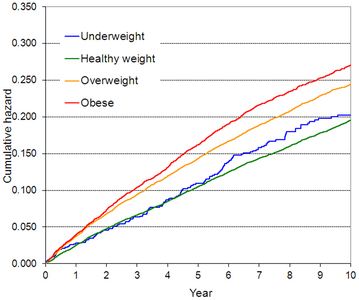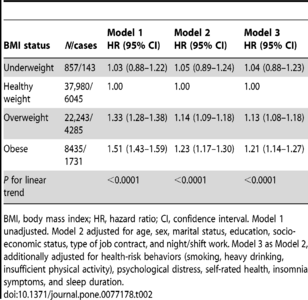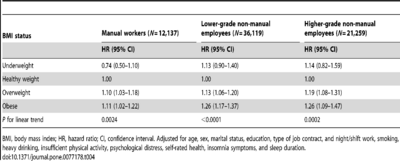Kouvonen, A;
Kivimäki, M;
Oksanen, T;
Pentti, J;
De Vogli, R;
Virtanen, M;
Vahtera, J;
(2013)
Obesity and occupational injury: a prospective cohort study of 69,515 public sector employees.
PLoS One
, 8
(10)
, Article e77178. 10.1371/journal.pone.0077178.

|
PDF
journal.pone.0077178.pdf Download (252kB) |
|
![[thumbnail of Graph 1]](https://discovery-pp.ucl.ac.uk/1421430/2.hassmallThumbnailVersion/journal.pone.0077178.g001.png)  Preview |
Other (Graph 1)
journal.pone.0077178.g001.png Download (144kB) |
![[thumbnail of Table 1]](https://discovery-pp.ucl.ac.uk/1421430/3.hassmallThumbnailVersion/journal.pone.0077178.t001.png)  Preview |
PDF (Table 1)
journal.pone.0077178.t001.png Download (186kB) |
![[thumbnail of Table 2]](https://discovery-pp.ucl.ac.uk/1421430/4.hassmallThumbnailVersion/journal.pone.0077178.t002.png)  Preview |
PDF (Table 2)
journal.pone.0077178.t002.png Download (50kB) |
![[thumbnail of Table 3]](https://discovery-pp.ucl.ac.uk/1421430/5.hassmallThumbnailVersion/journal.pone.0077178.t003.png)  Preview |
PDF (Table 3)
journal.pone.0077178.t003.png Download (43kB) |
![[thumbnail of Table 4]](https://discovery-pp.ucl.ac.uk/1421430/6.hassmallThumbnailVersion/journal.pone.0077178.t004.png)  Preview |
PDF (Table 4)
journal.pone.0077178.t004.png Download (51kB) |
![[thumbnail of Table 5]](https://discovery-pp.ucl.ac.uk/1421430/8.hassmallThumbnailVersion/journal.pone.0077178.t005.png)  Preview |
PDF (Table 5)
journal.pone.0077178.t005.png Download (148kB) |
Abstract
Background: Obesity and overweight are suggested to increase the risk of occupational injury but longitudinal evidence to confirm this is rare. We sought to evaluate obesity and overweight as risk factors for occupational injuries. Methodology/Principal Findings: A total of 69,515 public sector employees (80% women) responded to a survey in 2000–2002, 2004 or 2008. Body mass index (kg/m2) was derived from self-reported height and weight and was linked to records of subsequent occupational injuries obtained from national registers. Different injury types, locations and events or exposures (the manner in which the injury was produced or inflicted) were analyzed by body mass index category adjusting for baseline socio-demographic characteristics, work characteristics, health-risk behaviors, physical and mental health, insomnia symptoms, and sleep duration. During the mean follow-up of 7.8 years (SD = 3.2), 18% of the employees (N = 12,204) recorded at least one occupational injury. Obesity was associated with a higher overall risk of occupational injury; multivariable adjusted hazard ratio (HR) 1.21 (95% CI 1.14–1.27). A relationship was observed for bone fractures (HR = 1.37; 95% CI: 1.10–1.70), dislocations, sprains and strains (HR = 1.36; 95% CI: 1.25–1.49), concussions and internal injuries (HR = 1.26; 95% CI: 1.11–1.44), injuries to lower extremities (HR = 1.62; 95%: 1.46–1.79) and injuries to whole body or multiple sites (HR = 1.37; 95%: 1.10–1.70). Furthermore, obesity was associated with a higher risk of injuries caused by slipping, tripping, stumbling and falling (HR = 1.55; 95% CI: 1.40–1.73), sudden body movement with or without physical stress (HR = 1.24; 95% CI: 1.10–1.41) and shock, fright, violence, aggression, threat or unexpected presence (HR = 1.33; 95% CI: 1.03–1.72). The magnitude of the associations between overweight and injuries was smaller, but the associations were generally in the same direction as those of obesity. Conclusions/Significance: Obese employees record more occupational injuries than those with recommended healthy weight.
| Type: | Article |
|---|---|
| Title: | Obesity and occupational injury: a prospective cohort study of 69,515 public sector employees |
| Location: | United States |
| Open access status: | An open access version is available from UCL Discovery |
| DOI: | 10.1371/journal.pone.0077178 |
| Publisher version: | http://dx.doi.org/10.1371/journal.pone.0077178 |
| Language: | English |
| Additional information: | © 2013 Kouvonen et al. This is an open-access article distributed under the terms of the Creative Commons Attribution License, which permits unrestricted use, distribution, and reproduction in any medium, provided the original author and source are credited. |
| UCL classification: | UCL UCL > Provost and Vice Provost Offices > School of Life and Medical Sciences UCL > Provost and Vice Provost Offices > School of Life and Medical Sciences > Faculty of Population Health Sciences > Institute of Epidemiology and Health UCL > Provost and Vice Provost Offices > School of Life and Medical Sciences > Faculty of Population Health Sciences > Institute of Epidemiology and Health > Epidemiology and Public Health |
| URI: | https://discovery-pp.ucl.ac.uk/id/eprint/1421430 |
Archive Staff Only
 |
View Item |


